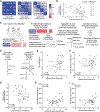Nascent Prostate Cancer Heterogeneity Drives Evolution and Resistance to Intense Hormonal Therapy
- PMID: 33785256
- PMCID: PMC8473585
- DOI: 10.1016/j.eururo.2021.03.009
Nascent Prostate Cancer Heterogeneity Drives Evolution and Resistance to Intense Hormonal Therapy
Abstract
Background: Patients diagnosed with high risk localized prostate cancer have variable outcomes following surgery. Trials of intense neoadjuvant androgen deprivation therapy (NADT) have shown lower rates of recurrence among patients with minimal residual disease after treatment. The molecular features that distinguish exceptional responders from poor responders are not known.
Objective: To identify genomic and histologic features associated with treatment resistance at baseline.
Design, setting, and participants: Targeted biopsies were obtained from 37 men with intermediate- to high-risk prostate cancer before receiving 6 mo of ADT plus enzalutamide. Biopsy tissues were used for whole-exome sequencing and immunohistochemistry (IHC).
Outcome measurements and statistical analysis: We assessed the relationship of molecular features with final pathologic response using a cutpoint of 0.05 cm3 for residual cancer burden to compare exceptional responders to incomplete and nonresponders. We assessed intratumoral heterogeneity at the tissue and genomic level, and compared the volume of residual disease to the Shannon diversity index for each tumor. We generated multivariate models of resistance based on three molecular features and one histologic feature, with and without multiparametric magnetic resonance imaging estimates of baseline tumor volume.
Results and limitations: Loss of chromosome 10q (containing PTEN) and alterations to TP53 were predictive of poor response, as were the expression of nuclear ERG on IHC and the presence of intraductal carcinoma of the prostate. Patients with incompletely and nonresponding tumors harbored greater tumor diversity as estimated via phylogenetic tree reconstruction from DNA sequencing and analysis of IHC staining. Our four-factor binary model (area under the receiver operating characteristic curve [AUC] 0.89) to predict poor response correlated with greater diversity in our cohort and a validation cohort of 57 Gleason score 8-10 prostate cancers from The Cancer Genome Atlas. When baseline tumor volume was added to the model, it distinguished poor response to NADT with an AUC of 0.98. Prospective use of this model requires further retrospective validation with biopsies from additional trials.
Conclusions: A subset of prostate cancers exhibit greater histologic and genomic diversity at the time of diagnosis, and these localized tumors have greater fitness to resist therapy.
Patient summary: Some prostate cancer tumors do not respond well to a hormonal treatment called androgen deprivation therapy (ADT). We used tumor volume and four other parameters to develop a model to identify tumors that will not respond well to ADT. Treatments other than ADT should be considered for these patients.
Keywords: Androgen deprivation therapy; Diversity; Enzalutamide; Evolution; Genomics; Immunohistochemistry; Neoadjuvant; Prostate cancer.
Published by Elsevier B.V.
Figures





Comment in
-
Reply to Alessia Cimadamore, Liang Cheng, Antonio Lopez-Beltran, Marina Scarpelli, and Rodolfo Montironi's Letter to the Editor re: Scott Wilkinson, Huihui Ye, Fatima Karzai, et al. Nascent Prostate Cancer Heterogeneity Drives Evolution and Resistance to Intense Hormonal Therapy. Eur Urol. In press. https://doi.org/10.1016/j.eururo.2021.03.009: Focus on Intraductal Carcinoma of the Prostate.Eur Urol. 2021 Sep;80(3):e83-e84. doi: 10.1016/j.eururo.2021.06.002. Epub 2021 Jun 18. Eur Urol. 2021. PMID: 34148711 No abstract available.
-
Re: Scott Wilkinson, Huihui Ye, Fatima Karzai, et al. Nascent Prostate Cancer Heterogeneity Drives Evolution and Resistance to Intense Hormonal Therapy. Eur Urol. In press. https://doi.org/10.1016/j.eururo.2021.03.009: Focus on Intraductal Carcinoma of the Prostate.Eur Urol. 2021 Sep;80(3):e81-e82. doi: 10.1016/j.eururo.2021.06.001. Epub 2021 Jun 18. Eur Urol. 2021. PMID: 34148712 No abstract available.
References
-
- Hamdy FC, Donovan JL, Lane JA, et al. 10-Year outcomes after monitoring, surgery, or radiotherapy for localized prostate cancer. N Engl J Med 2016;375:1415–24. - PubMed
-
- Boutros PC, Fraser M, van der Kwast T, Bristow RG. Clonality of localized and metastatic prostate cancer. Curr Opin Urol 2016;26:219–24. - PubMed
-
- Espiritu SMG, Liu LY, Rubanova Y, et al. The evolutionary landscape of localized prostate cancers drives clinical aggression. Cell 2018;173:1003–13.e15. - PubMed
Publication types
MeSH terms
Substances
Grants and funding
LinkOut - more resources
Full Text Sources
Other Literature Sources
Medical
Molecular Biology Databases
Research Materials
Miscellaneous

